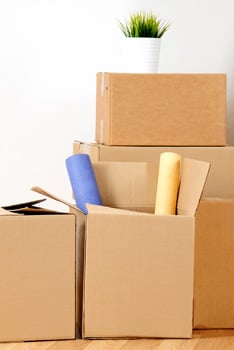Moving house is a physical and logistical challenge.
According to our own research, 31% of people who’ve moved house in the last five years say they’ve injured or hurt themselves during the process. The majority of that 31% say they’ve injured their back while attempting to carry heavy items.
Other common injuries include scraped knuckles from attempting to fit wide loads through narrow spaces, trapped fingers, injured toes and an assortment of bumped heads and on the latter, all occurred through (non-professional) house-movers attempting to stand up inside the back of a van.
As well the sheer energy required to get a house move – especially a London house move – completed, a good house move takes planning, logistical insight and a good degree of project management.
To make the process easier and less physically risky, we assembled a team of logistical, engineering and materials experts to plan the perfect move based on their respective and collective areas of expertise. That team includes a highly qualified civil engineer and British Territorial Army officer in Kiwi Movers’ own Matt Lowe, former British Army major and now Kiwi Movers director Regan McMillan and Dr. Greg Moakes PHD, an expert in materials science.
Here’s their advice:
Pre-move considerations
“Planning is everything” says Matt. “With the right plan you can identify hurdles, save time and shave hours off of the time it takes you to move. This of course will save you money, as well as hassle.”
Matt stresses the importance of taking a ‘reductive’ approach to the early stages of planning. In other words, be prepared to throw stuff away:
Things to get rid of:
Start planning this one month ahead of your move. Consider throwing out clothes you haven’t worn in six months and consolidate paper by scanning and storing digitally. A week before your move, throw away any food that will be out of date by the time you’ve completed your move. If you are moving your refrigerator, stop buying frozen items a month before your move to use up your frozen items and avoid waste.
When to defrost the freezer before a house move
A good rule of thumb is that if you are moving the refrigerator, asses the time it will be unplugged for. If you can move it within 30 minutes, don’t defrost. If longer, start defrosting two days before the move.
What to keep around until the day of the move
Two days before your move, pack a suitcase of clothing, food, cleaning and toiletries. This is your camping kit and never goes in the back of the removals van. This will minimise the stress of moving by making it totally unnecessary to immediately unpack if you happen to be exhausted after the move.
The importance of labelling boxes
- Pick a packing station (if it’s nice weather, use the lawn) to assess how many trips you will need
- Box by room, and label by room, especially if hiring helpers
- Pack a special “open first” box last with food and drink essentials to get you through the first 1-2 days for the same reason as the suitcases above
Packing & Logistics
You should set a maximum exertion level that no single person involved in the move goes above. This helps reduce the risk of injury, fatigue and, if we’re being honest, tantrums.
According to the Niosh Lifting Equation, if conditions are optimal then healthy adult humans should be able to carry somewhere 51 lbs or 23 kg of weight. This assumes < 8 hrs with a recuperation time between work of at least 0.3x the duration of the work.
However, the optimal weight consideration doesn’t account for the extra stress to the body caused by carrying cumbersome or awkwardly shaped loads.
Dr. Moakes, who has extensive experience in the field of materials science stresses the importance of respecting the properties of different materials, offers this advice.
“It’s easier to move 20kg of books than it is to move a 20 kg mattress. For example, you can split the books into smaller batches, stack them, carry them on a dolly or lift from an elevated surface to give yourself a host of advantages. But a mattress is just one big floppy slab of weight that drags, snags and scuffs at will. Always be mindful of the different challenges posed by different materials.”
Moving boxes – which ones to use and when
A 1.5 cubic foot moving box, which is 16 x 12½ x 12½ inches can safely carry up to 60 lbs. But you should keep the weight under 50 lbs. This sort of box is great for books, for packing kitchen items, dishes, fragile and small appliances, lamps or shades.
This is the largest box you should carry without another person or a dolly or trolly. The reason for this is that the box measures 48 inches around which is approximately 0.8x the average human arm span.
A 3.0 cubic foot moving box which is 18 x 18 x 16 and can safely carry up to 65 lbs – clothing, pots and pans and electronics.
A 4.5 cubic foot moving box which is 18 x 18 x 24 and can safely carry up to 65 lbs.- larger lamps, linens and larger kitchen appliances.
A 6.0 cubic foot moving box which is 22 x 22 x 21 ½ and can carry up to 70 lbs – use for large, light items like duvets since overfilling will make it cumbersome to move.
Packing order reminder – optimising the house move process
Heavy furniture first, then heavy boxes, then a second and third layer.
Where to keep important paperwork during a house move
All important paperwork and valuables should be kept out of site in the cab of the moving truck, or in a separate vehicle. Reasons for this are:
- To reduce the likelihood of loss when mixed among the possessions in the primary storage area.
- To reduce the stress associated with short-term loss of said valuables when mover inevitable forgets whether or not he/she packed the items in boxes now stored in the primary storage area.
Unpacking after a house move
Packing and unpacking should be performing according to human needs. (the higher the need for the room, the later to pack , earlier to unpack). Human essentials are water, food, sleep, sanitation and leisure in that basic order. As such:
Packing:
- Garage
- Living Room
- Bathroom (exception of essentials like toilet paper)
- Bedroom
- Kitchen
Reverse for unpacking
- Kitchen
- Bedroom
- Bathroom
- Living room
- Garage
Should you ever use supermarket boxes when moving house?
It’s so tempting to pop down to Tesco and blag a few of their boxes for the move. If you have a one-bed apartment and aren’t moving anything more than your clothes and a few books, this is fine. Supermarkets and “bix box stores” will allow you to take boxes. However, consider the following.
- Thickness of cardboard is optimized to be just enough to carry the goods to minimize cost. A box designed to carry Walkers crisps was not optimised to carry your dumbbells.
- Sizes of boxes vary wildly and minimize your ability to plan the number of boxes required will suffer
- Integrity is often compromised since the boxes have already been used and there may have seen spills that you are not aware of.
Rules of thumb:
If you have two rooms worth of furniture, use a man-and-van service
If you have more than two rooms of furniture, or expensive/heavy items, use a home removal service













